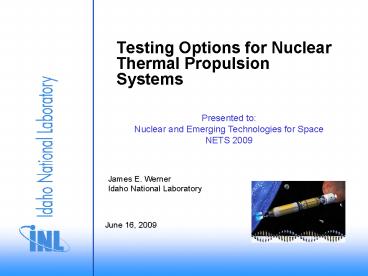Testing Options for Nuclear Thermal Propulsion Systems - PowerPoint PPT Presentation
1 / 14
Title:
Testing Options for Nuclear Thermal Propulsion Systems
Description:
... series to demonstrate Basic nuclear technology. KIWI. Phoebus. Pewee-1 ... KIWI, Phoebus, and Pewee-1; open cycle systems and exhausted their effluent into ... – PowerPoint PPT presentation
Number of Views:28
Avg rating:3.0/5.0
Title: Testing Options for Nuclear Thermal Propulsion Systems
1
Testing Options for Nuclear Thermal Propulsion
Systems
Presented to Nuclear and Emerging Technologies
for SpaceNETS 2009
James E. Werner Idaho National Laboratory
June 16, 2009
2
NERVA Program
- Four reactor test series to demonstrate
Basic nuclear technology - KIWI
- Phoebus
- Pewee-1
- Nuclear Furnace-1
- KIWI, Phoebus, and Pewee-1 open cycle systems
and exhausted their effluent into the atmosphere - Nuclear Furnace-1 used an effluent treatment
system - Between 1959 and 1972, the Space Nuclear
Propulsion Office oversaw 23 reactor tests
3
Why Build a Nuclear Rocket?
- Three times the ISP of chemical engines
- its have been shown to be
- Faster
- Reduced Transit times for long stay missions
- Reduced round trip times for short stay missions
for the same initial mass to low earth orbit
(IMLEO) - Cheaper
- Reduced IMLEO requirements for the same mission
duration - Greater mission flexibility for VSE Mars (cargo
and especially piloted) missions with respect to
departure windows - Fewer launches required
- Fewer supplies, equipment, power needed
- Better
- One propulsion system capable providing a step
change capability in meeting many exploration
mission needs - Technology within developmental timeframe
- Reduced exposure for manned missions
4
Basic Options
- Ground test with the US
- Ground test remotely (i.e. in an ocean)
- No ground test
5
Elements of a Ground Test Facility
- Facilities
- Containment Building
- Control Building
- Test Cell
- Exhaust Treatment System
- Hydrogen Supply System
- Cold Engine Assembly Building
- Hot Engine Disassembly Building
- other support systems and buildings
- Dependent on size (thrust), thermal power level
and duration - NTR engine physical size modestly affects size of
containment building
6
Test Facility Concepts
- Above Ground Effluent Treatment System (ETS)
- Subsurface Active Filtration of Exhaust (SAFE)
Test Facility - Other?
7
Effluent Treatment Systems Needs
- Cooling the hydrogen effluent
- Removing particles from the gas flow stream
- Further reduction of the temperature
- Removing the water and dissolved fission products
- Removing the noble gases
- Flaring the exiting hydrogen stream (containing
no detectable fission products)
8
SNTP Effluent Treatment Systemfor 550 MWt
9
Parametric Estimation of ETS Costs
Cost Factors Based on NTP Thrust Normalized
for 25klbf NTR
10
Subsurface Active Filtration of Exhaust (SAFE)
Test Facility
- Filtration of the engine exhaust using the NTS
alluvium soil / rock as the holdup and active
filtration medium - relies upon the alluvial soil characteristics to
filter the effluents from the NTR exhaust - Nozzle exit is sealed at the surface
- Exhaust pressure will drive exhaust and water
vapor into the porous soil or rock at a rate
equal to the NTR mass flow - Could be operated for long periods over a wide
range of engine thrust levels
11
SAFE Facility Description
- Uses a borehole 8 feet in diameter by 1200 feet
deep - Upper 100 feet would be steel encased
- Cooling water would be sprayed into the borehole
to limit the exhaust temperature - Maximum back pressure buildup in the borehole
would be 36 psi - Independent study by the Desert Research
Institute (DRI) Some radionuclides would reach
the surface within several years after injection
but, at acceptably allowable levels for the NTS
12
Comparison between ETS and SAFE
- ETS
- Pros
- No large quantity of contaminated liquid effluent
will be generated. - Altitude simulation may be possible with this
system. - A center for ground testing with dedicated test
facilities could be established for NTP systems
up to the design rating. - Performance of the system will be well
characterized after initial testing. - Cons
- Large quantities of liquid hydrogen will be
required for each test. - Large, complex effluent filtration systems have
not yet been demonstrated. - Public acceptance of once through exhaust
treatment with discharge to the atmosphere may be
challenging. - Containment isolation system during abnormal
events may be complex.
13
Comparison between ETS and SAFE
- SAFE
- Pros
- No active effluent treatment system required.
- Existing boreholes are available.
- Less hydrogen will be required per test.
- Potential for significant costs savings
- Cons
- Further studies could show the need for waste
coolant water removal and a filtration system. - Boreholes may have limited reuse capability and
require relocation of certain GTF assets, (e.g.,
portable containment structure). - Monitoring of borehole alluvial soil performance
during and after testing will be required.
14
Next Steps
- Fuel Development - driving force for the design
of the effluent treatment system will be the
integrity of the fuel under normal operating and
abnormal operating conditions. Limited
information available as to how much of the
halogen or noble gases can be retained in the
fuel (needed for both ETS and SAFE) - Demonstration of Subsurface Filtration System - a
subscale proof of concept test is needed - Gas would be spiked with Krypton-85 to permit
monitoring of the gas permeation in the alluvial
soils - ambient and elevated temperature tests could be
performed































